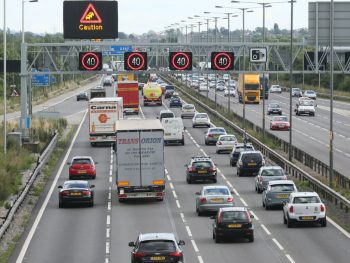Six in 10 drivers think smart motorways should be scrapped
The majority (62%) of drivers think that all-lane running (ALR) smart motorway schemes should be scrapped entirely and the hard shoulder reinstated, but with breakdown-detection tech kept.

The Transport Committee inquiry will look at whether safety on smart motorways can be improved, how public confidence can be increased and if a rethink is needed
Only a quarter (24%) of the 2,600-plus drivers surveyed by the RAC supported government plans to continue the roll-out of ALR motorways – where the hard shoulder is permanently converted to a running lane – backed by the increased safety measures announced earlier this year. These include more frequent use of emergency refuge areas and radar-based Stopped Vehicle Detection (SVD) technology, as a result of the 18-point action plan announced in March 2020 in response to a Department for Transport review.
Most drivers (63%) also don’t believe measures being introduced by National Highways on smart motorways – such as variable speed limits, closed-lane signs, SOS emergency refuge areas and SVD technology – are sufficient. Just 15% stated they thought they were adequate, with a fifth (21%) unsure.
Motorists’ safety concerns over smart motorways are also on the rise – 24% of drivers said this was one of their top overall motoring concerns, up from 16% last year. Meanwhile, 84% believe that safety is compromised by the permanent removal of the hard shoulder – up from 67% when drivers were last asked this in the 2019 RAC Report on Motoring.
And less than half of drivers (43%) who have driven on all-lane running stretches of motorway feel safe on them, while 30% say they don’t feel very safe and a quarter (24%) state they feel ‘very unsafe’.
That’s despite findings from ongoing National Highways research indicating that smart motorways are safer than conventional motorways – latest research by the Office of Road and Rail (ORR) suggests no errors have been made in the analysis although it says more data is needed.
The RAC said it’s always had safety concerns about all-lane running motorways and that most drivers will only be satisfied if hard shoulders are re-introduced.
But it added that switching to using the ‘dynamic hard shoulder’ version of smart motorway schemes, which only open the hard shoulder to traffic at busy times of the day, could provide a solution.
RAC head of roads policy Nicholas Lyes continued: “These schemes could be made the new standard as they still offer somewhere to stop away from live traffic in the event of a breakdown during quieter times, while still accommodating more traffic at busy times. They have also demonstrated very good levels of safety. What’s more, all the technology that’s been installed for all-lane-running would continue to be of valuable use, making dynamic hard shoulder schemes even safer.
“Arguably, all that would be needed is to repaint the sold white hard shoulder line and potentially some additional gantry signs.”
He added: “We would also like to see the ‘red X’ closed-lane symbol illuminated whenever the hard shoulder is not being used as a running lane alongside variable message signs indicating the hard shoulder is for emergency use only so drivers clearly know it’s not in use. That way there is no confusion and anyone who has to stop due to a breakdown or incident is likely to be better protected.”
In January 2020, MPs on the All-Party Parliamentary Group (APPG) for Roadside Rescue And Recovery have said that all-lane running schemes had been rolled out in the UK with “a shocking degree of carelessness” and without taking necessary steps to ensure the safety of motorists and recovery operators.
Roadside recovery and road safety specialists have also expressed concerns in recent years that features on the UK’s original smart motorway schemes, including the dynamic hard shoulder deployed on the M42 and M4/5, had not been carried over to today’s all-lane running smart motorways and that SOS areas are up to 1.6 miles apart, twice the distance on the original dynamic hard shoulder schemes.












